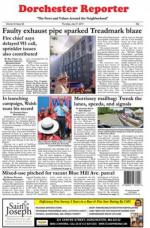March 14, 2018
Is building an aerial gondola over the streets of Boston’s Seaport district a good idea? Maybe it is. Maybe it isn’t.
But, whatever its merits or shortfalls, we hope that Boston’s political, business, and media leaders will slow their roll on any new ideas like this $100 million gondola until the long-deferred question of transit equity for our neighborhoods is resolved.
The Fairmount/Indigo Line– now a commuter rail line that runs through the heart of Dorchester, Mattapan, and Hyde Park on its way from Readville to South Station and back— should be the first priority for our leaders.
Can’t we invest in making the Fairmount run a full-service, urban line akin to the Red Line and plan for a some future, privately funded gondola? Ideally, yes, but the last year has given us fresh concern that city and state leaders aren’t as committed as they claim to be when it comes to making the Fairmount their true focus.
Now, with the tourist-friendly gondola scheme dangling like a snow-globe distraction above our heads, there’s new reason to worry and to push back.
At first blush, the notion of adding an overhead gondola to the menu of transportation options for the Seaport is certainly worthy of consideration. The devil is in the details. While the private firms behind the deal say they’d pay the $100 million to build the infrastructure, it’s not yet clear who would maintain it in the years to come.
Would it be operated as an MBTA branch or perhaps by a new quasi-public agency? Will long term maintenance and operation costs be shouldered by the public? All fair questions— and ones that will no doubt be part of ongoing coverage of this still-emerging idea.
But where are the deep-dive news reports and the political firepower when it comes to advancing the Fairmount Line? Sadly, it has been all too quiet on this front.
Last year, we reported that Rep. Evandro Carvalho introduced a bill that— if passed— would instruct the MBTA to boost ridership and access along the 9.2-mile line by launching a two-year pilot program in which Fairmount trains would run every 15 minutes at peak times.
Sadly, Carlvalho’s bill landed like a dead Red Line engine within the MBTA and it has not moved an inch in the Legislature. Last September, Mayor Walsh said he would propose his own 11-month pilot for the Fairmount Line— which he has hailed as a key part of the city’s 2030 plan. It’s effectively a scaled-back version of Carvalho’s plan.
“One fifth of Boston’s population lives along this nine-mile stretch,” Walsh correctly told a Chamber of Commerce audience as he rolled out news of his idea. “And 83 percent of those folks are black and Latino. They deserve better service, and from an economic perspective, they are an underutilized workforce in our city that we need to activate.”
Walsh is right, of course. But, even this modest proposal by the mayor of Boston has gone nowhere. Why?
Earlier this month, a coalition of transit advocates that is pushing for more thoughtful rail investments by city and state governments made the Fairmount Line a key plank in their report, “Transit Matters.” It’s their “Exhibit A” for how Massachusetts can make sensible investments in existing rail infrastructure and get the biggest bang for our collective buck.
The line, the report notes, already has most of the infrastructure it needs to morph into a high frequency, urban-core line. It has high-level platforms, access to electrical substations, and seven stations within the city, with an eighth —Blue Hill Avenue in Mattapan— now under construction.
The report underlines what community leaders have been arguing for decades now: The elements needed to make the Indigo Line a reality are within reach, if our state and city leaders get focused and serious about making this line what it should be: a viable transit option for the residents of Boston who for years have watched suburbanites zoom by on trains as they’ve boarded crowded buses.
Do you want to have a serious conversation about building public buy-in for a gondola? Fine. Let’s start by getting down to brass tacks on the Fairmount-Indigo line, which can’t even get a hearing on a test-run for faster, more reliable service. Let’s start with the actual rail tracks that are being underused in our backyards— and then turn our eyes to the Seaport skies.
Topics:



